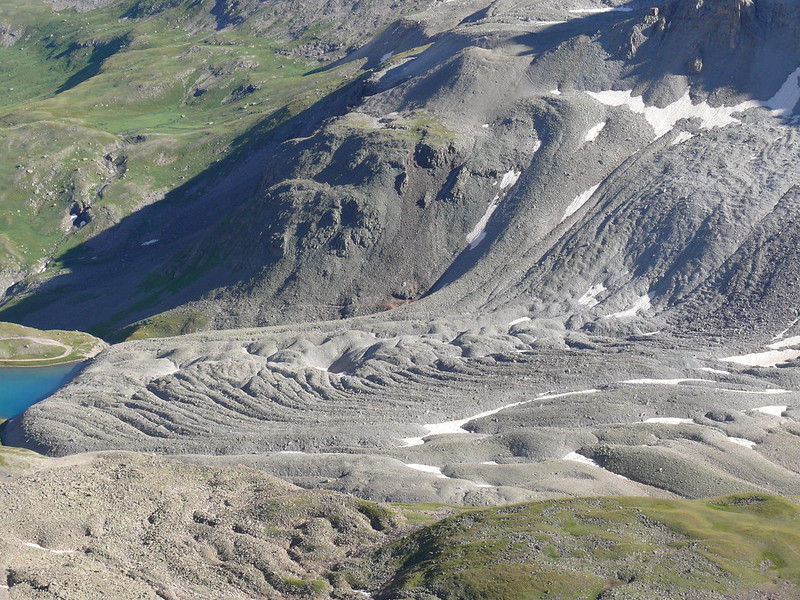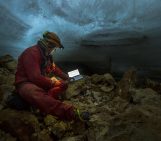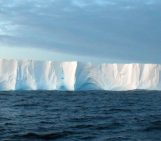
When speaking about glaciers and the ice they contain, we generally picture large, clean, and therefore relatively white mountain glaciers… But did you know about rock glaciers? From our Image of the Week, you might notice that they do not quite look like the classic ice glacier you might have had in mind. Indeed, they actually indicate the presence of mountain permafrost, an often poorly understood and rarely mentioned feature of the cryo-world. So, what exactly are these rock glaciers? Do they actually contain some ice? And if so, how much? Keep reading to learn all about this little-known mountain landform!
So… what is a rock glacier?
Rock glaciers are masses of frozen debris (a mixture of rocks, ice, snow and mud) that (similar to ice glaciers) slowly move down a mountain under the influence of gravity. More specifically, they slide downslope due to melting or deformation of ice, through a movement defined as “creep”. That movement creates a typical uneven and folded surface, described as “ridges and furrows”, similar to lava flow (see Fig. 2 below). Rock glaciers can be stable or move up to meters per year. Their surface is covered with angular boulders, while fine material accumulates in the lower parts.
Rock glaciers can form in various ways. Some derive from ice glaciers, for example from the melting of a glacier that was covered by a landslide. Others can form if water percolates or infiltrates through the sediments and freezes. In any case, rock glaciers are indicators of the presence of permafrost (a layer of constantly frozen ground) in mountain environments.

Fig. 2. The typical “ridge and furrow” surface of rock glaciers [photo credit: Bob Wester for NSIDC]
What about the amount of ice stored inside rock glaciers?
In rock glaciers, ice is generally not visible at the surface, as it is contained in the inner parts. On average, 40-60% of a rock glacier’s composition is ice.
In 2015, a study by Krainer et al. analyzed the active rock glacier of Lazaun, located in South Tyrol (Italy). Thanks to two core drillings, they discovered that the ice content is highly variable within the rock glacier, depending on the location of the borehole and the drilling depth: locally, it can vary from 0% to 98%! Typically, the ice content is higher upstream, near the rock glacier root. The study found out that the Lazaun rock glacier stores approximately 800.000 m3 of ice (the equivalent of about 320 Olympic-size swimming pools!) out of 0.12 km2 rock glacier extent (more than 10 times the area of a football field): quite a significant amount of ice! In the Italian Alps alone, 1594 rock glaciers were identified… can you imagine how much ice might be hidden in rock glaciers all over the world?!
Rock glaciers as a water resource?
Rock glacier ice melts at slower rates than regular glacier ice due to the presence of a top active layer (the top layer that thaws in summer and freezes in winter) that protects the ice inside. This provides a longer-lasting water resource. But is rock glacier meltwater drinkable? Only a few studies have focused on this aspect (for example this one or this one). Alpine lakes located in catchments where rock glaciers are present revealed the presence of heavy metals in the water. Ongoing climate change increases permafrost thaw and consequent rock weathering, causing an increase in heavy metals in the water (such as nickel and manganese) above the thresholds considered safe. Permafrost thaw not only may affect potentially potable water, but it also impacts freshwater habitats, causing ecosystem modifications. However, considerable research gaps exist on the topic, so future scientific investigation of this is required! Indeed, we do not know for certain where climate change will lead us, so the study of new accessible water resources is of prime importance.
Further readings
- Did you know… about the ice content in mountain permafrost? – Cryoblog post on debris cover and glaciers
- The Internation Permafrost Association, Rock glaciers Action Group web page
- Brighenti, S., Tolotti, M., Bruno, M.C., Wharton, G., Pusch, M.T., Bertoldi, W., 2019. Ecosystem shifts in Alpine streams under glacier retreat and rock glacier thaw: A review. Sci. Total Environ. 675, 542–559. https://doi.org/10.1016/j.scitotenv.2019.04.221
- Jones, D.B., Harrison, S., Anderson, K., Whalley, W.B., 2019. Rock glaciers and mountain hydrology: A review. Earth-Sci. Rev. 193, 66–90. https://doi.org/10.1016/j.earscirev.2019.04.001
- Knight, J., Harrison, S., Jones, D.B., 2019. Rock glaciers and the geomorphological evolution of deglacierizing mountains. Geomorphology 324, 14–24. https://doi.org/10.1016/j.geomorph.2018.09.020
- RGIK, 2020. Rock glacier inventory using InSAR (kinematic approach), Practical Guidelines v3.0.2.
- Thies, H., Nickus, U., Mair, V., Tessadri, R., Tait, D., Thaler, B., Psenner, R., 2007. Unexpected Response of High Alpine Lake Waters to Climate Warming. Sci. Technol. 41, 7424–7429. https://doi.org/10.1021/es0708060
- Krainer, K., et al., A 10,300-year-old permafrost core from the active rock glacier Lazaun, southern Ötztal Alps (South Tyrol, northern Italy), Quaternary Research (2014), http://dx.doi.org/10.1016/j.yqres.2014.12.005
Edited by Vio Coulon
 Federica Minotti is a PhD student at Università di Bologna, Italy. Her research focuses on the interaction between glaciers and sediment transfer. She is part of the SedInOut Italy-Austria Interreg Project, focusing on the development of a risk management methodology through the assessment of sediment availability for mass movements in mountain environments. She tweets as @MinottiFederica. To contact her, please write to federica.minotti2@unibo.it
Federica Minotti is a PhD student at Università di Bologna, Italy. Her research focuses on the interaction between glaciers and sediment transfer. She is part of the SedInOut Italy-Austria Interreg Project, focusing on the development of a risk management methodology through the assessment of sediment availability for mass movements in mountain environments. She tweets as @MinottiFederica. To contact her, please write to federica.minotti2@unibo.it




